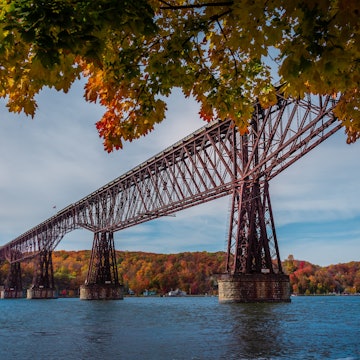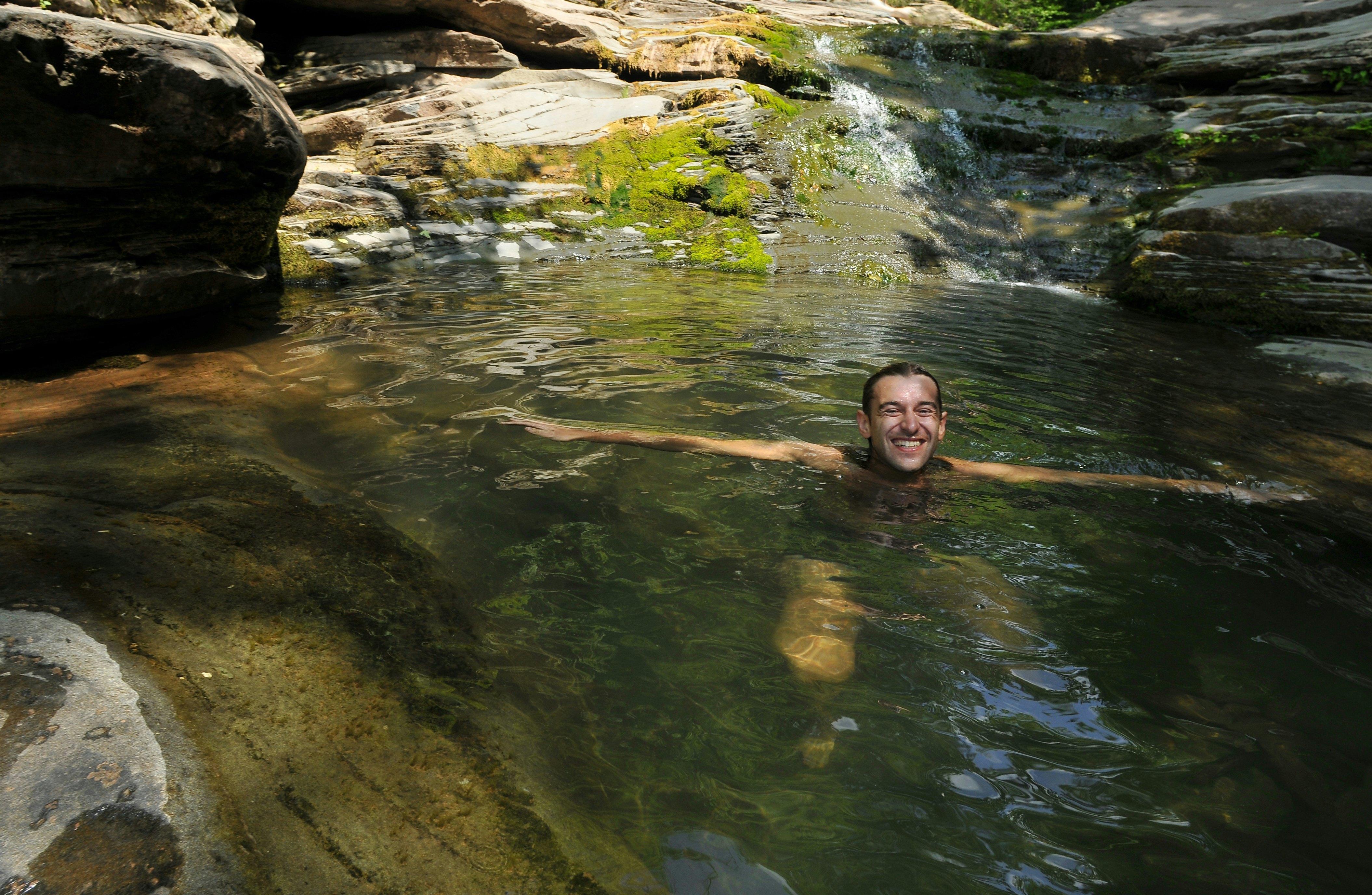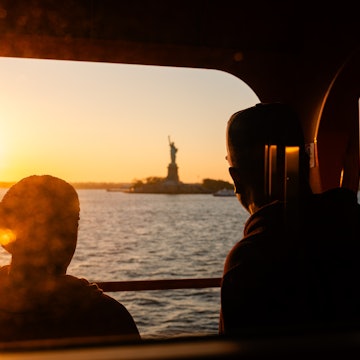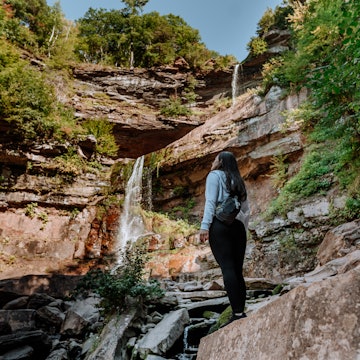
The 8 best hiking trails in the Catskills for every fitness level

Dec 30, 2021 • 9 min read

Expect spectacular views on many of these hikes in the Catskills © Dan Hanscom / Shutterstock
Craggy cliffs cut by rivers, filled with old-growth forests, and flowing with waterfalls. These are the Catskills: a wild refuge two hours north of New York city where urbanites escape the hustle-bustle to explore the sublime.
The rolling plateaus of the Catskills offer a dynamic line-up of trails fit for all levels of fitness so it's no surprise that hiking is one of the top things to do here. Snap pictures of the state's tallest cataracts, try your luck on the East Coast's most daunting paths or glide along paved roads to see why millions of travelers fall in love with this region every year.
Sam's Point Area: best hike for diverse landscapes
7.4 miles round trip, 4-5 hours, moderate
Sam's Point is the over-achiever of Catskills trails: instead of one jaw-dropping destination, it has three. The first of these spots is the area's eponymous lookout, located less than a mile from the parking lot. After climbing a steady paved path, step onto the flat, bald-faced ledge to see the Shawangunk Ridge and Wallkill Valley unfurling below.
Continue onward through a scrubby forest of huckleberry and pitch pine trees until you reach the ice caves – a series of chilly crevices where snow lingers well into July. Wood planks and ladders clearly mark the loop trail as it winds through the rocks. The caves may be impassible if you visit between late autumn and early spring; check at the visitor's center before beginning your hike.
To reach the third site, backtrack to signs for Verkeerderkill Falls – a 187ft cascade that roars most impressively in spring and early summer. A sign along the trail exclaims "This is one of Earth's last great places" – a bold statement you'll have trouble refuting.

Kaaterskill Falls: best waterfall hike
1.6 miles round trip, 1-2 hours, easy to difficult
Kaaterskill Falls isn't only one of New York's tallest cascades – it's also one of the most famous. Thomas Cole, founder of the Hudson River School, replicated the site in his romantic 19th-century landscapes. Washington Irving featured the "sheet of feathery foam" in Rip Van Winkle, his legendary tale from 1819. Today, everyone from plein air painters to camera-happy hikers captures the two-tiered, 260ft waterfall as a work of art, enticing an estimated 100,000 people a year to follow in their footsteps.
A series of forested trails starting at Laurel House Road give hikers the option to choose their own adventure. For a quick, family-friendly stroll, head to the upper falls observation deck and wait in the steady stream of visitors waiting to pose for photos. To see both cataracts, take the strenuous 200-stair descent to the lower fall's base. From here, scramble over river rocks until you find a sturdy platform to admire the scenery.
This is also one of the best places to swim in the Catskills. On hot summer days, the more daring cool off in the refreshing watering hole below the upper falls. In winter, skip the icy downward climb and stick to the observation deck to see the frosted landscape from above. You'll likely encounter large crowds during autumn's leaf-peeping season – one of the best times to visit the Catskills - but it's a price worth paying to see such natural beauty.
Bonticou Crag: best hike for beginner-level rock climbing
2.3 miles round trip, 2 hours, difficult
Mohonk Preserve, located on the southeastern edge of the Catskills, covers over 8,000 acres and contains nearly 70 miles of trails. Choosing the proper hike can be a challenge, though not nearly as challenging as the trail to Bonticou Crag.
Don't be fooled by the trail's unassuming start. Meadows filled with eye-high grasses lead to a gravel road winding through peaceful woodlands. It isn't until you reach the Bonticou Ascent Path, marked in yellow, that the difficulty level dramatically increases. Here, the cliffside shoots above the treeline, and hikers must climb a short but intense rock pile to reach the top.
Brave hikers reap big rewards: the white quartz-and-sandstone summit offers 360-degree views of the region. Sit back on one of the ledges and refuel with a light snack before starting the descent. Luckily, you don't have to go down the way you came. Follow yellow arrows near the climbing area to walk down the mountain's backside. If this quick loop is still too easy, tack on a few extra miles by hiking to Table Rocks, a tranquil cliffside outcropping that doesn't require climbing.
Read more: 7 best road trips in the Catskills
Overlook Mountain: best hike for panoramic views
4.6 miles round trip, 3 hours, moderate
The steep gravel road used to scale Overlook Mountain might not be the bucolic footpath of a John Muir daydream, but this hike above the town of Woodstock isn't entirely about the journey – it's about the destination. From the 3140ft summit, hikers can spot the Ashokan Reservoir glistening to the south and Hudson River Valley unfolding eastward. If the sights from here aren't grand enough, scale the 60ft fire tower to change your point of view.
Before the hike begins, check out Karma Triyana Dharmachakra, a Tibetan Buddhist monastery where strings of colorful prayer flags flap in the wind. As you continue along the path, it's impossible to miss the ruins of a century-old hotel that welcomed guests from the early 1800s through the early 1900s. In 1940, the property was sold to New York State following a plague of slow business, fires, and shoddy reconstruction. While you're not likely to find ghosts from the hotel's heyday rustling among the abandoned rooms, do stay vigilant for signs of timber rattlesnakes, which occasionally slither along the trail.

Ashokan Reservoir Promenade: best ADA-approved hike
5.4 miles round trip, 2 hours, easy
You don't have to climb the Catskill Mountains to marvel at their magnificence. This is particularly true along the wheelchair-accessible Ashokan Reservoir Promenade – a flat, paved trail hugging the water's southern shoreline as it stretches from Slide Mountain to Esopus Creek.
Although it may seem like a natural part of the landscape, this lake did not exist until the early 1900s. As New York City's population began booming, lawmakers looked toward the Catskills to find residents an adequate source of clean drinking water. Their solution was building this reservoir – but only after displacing roughly 2000 people and clearing 10,000 acres of land. The 123-billion-gallon tank now provides Big Apple residents approximately 40% of their daily drinking water in non-drought seasons.
With the water came new kinds of communities. Today, families of trout, salamanders, frogs, and turtles call the Ashokan Watershed their home. Bald eagles nest in the maple and pine forests lining the shore, and white-tailed deer graze among grasses adjacent to the esplanade. Stroll, jog, or roll your way along the path and you'll understand why so many animals covet this century-old real estate. Plan your trip just before dusk to see the sunset’s neon palette reflected in the reservoir.
Devil's Path: best hike for adventurous backpackers
25 miles from point to point, 2-3 days, very difficult
West Coast climbers familiar with the rugged Rocky Mountains will call most New York trails child's play until they attempt the Devil's Path. With six peaks covering over 14,000ft in elevation change, this is widely regarded as the East Coast's most challenging through hike.
The arduous path is not for the faint of heart. Daring souls who attempt the trail usually spend three days camping in lean-tos and purifying their water from streams as they backpack along the east-to-west route. Unpredictable weather, rocky scrambles, and run-ins with black bears are par for the course.
But for all its danger, the Devil's Path is undeniably Edenic. For the majority of the trail, hikers will find themselves far enough from civilization to enjoy an abundance of wild waterfalls, thick forests, and spectacular vistas in solitude. If the payoff isn't worth the punishment, consider a day hike along some of its shorter sections, like the 7-mile Indian Head Loop Trail or the path to Plateau Mountain. Devil's Tombstone Campground – a popular site along Notch Lake – offers access near the route's midpoint.

Beer Mountain
Best trail for non-hikers
30 minutes, easy
If you can't commit to a full-fledged hike, consider taste testing the Catskill's natural landscape near the trendy town of Livingston Manor. Upward Brewing Company, a microbrewery favored by local hop heads, serves its suds with a side of hiking. Follow the sign near the chalet-style pub to climb up the property's aptly named Beer Mountain (not to be confused with Bear Mountain State Park).
The path starts with a steep ascent through a calm forest, then follows a rocky road to a meadow framed by rolling hills. It might not pack the same punch as other hikes on this list, but that’s not the point. This quick jaunt is just an excuse to order another beer after tricking nature naysayers into giving the mountains a go.
Tusten Mountain Trail
Best historic hike in the Delaware Valley
3 miles round trip, 1-2 hours, easy to moderate
Cross the rocky Ten Mile River as it ambles toward the mighty Delaware and you'll find yourself at the foot of Tusten Mountain – a gentle slope that climbs nearly 600ft to a bird's eye view of the Western Catskills. You might spot a few locals from nearby Narrowsburg strolling along the forested path, but you're more likely to see a variety of avian travelers soaring through the canopy. Songbirds flit about at eye-level in spring and autumn, and if you look up, you may catch a turkey vulture or bald eagle surveying the landscape.
While driving along the dirt road leading to the hike, it's possible to make out remnants of early colonial communities. The short-lived Reeves Mill settlement occupied this area in the mid-18th century, followed by the 19th-century Tusten settlement, which set up workshops like a sawmill, gristmill, and quarry to take advantage of the area's natural resources. A historic stone arch bridge made of native bluestone greets hikers at the trailhead.
Tusten is a trail for all seasons, but the surroundings are most splendid in fall, when changing leaves of beech, oak, and maple trees put on a kaleidoscopic art show. For a less strenuous climb, follow the loop trail counter-clockwise. Pack a lunch and spread out on one of the river's many flat rocks to enjoy a post-hike picnic.
You might also like:
How to plan the perfect Catskills weekend getaway
Get your hygge on in the Catskills in these Scandi-style cabins
When is the best time to visit US and Canada's national parks?















